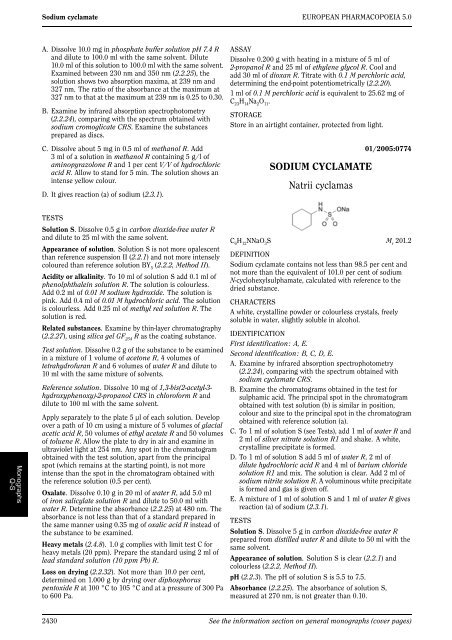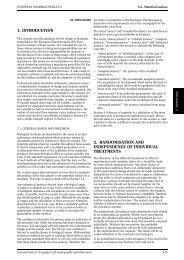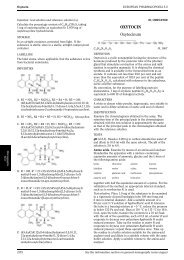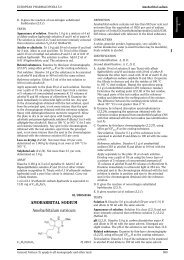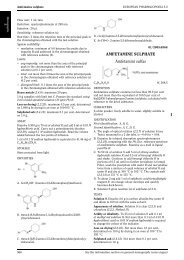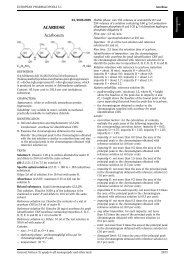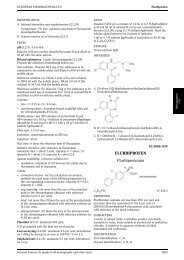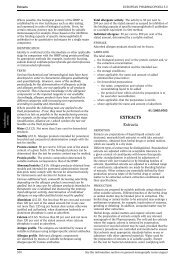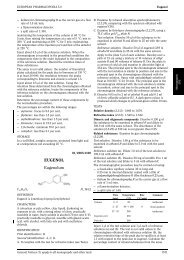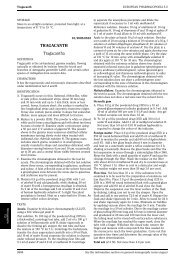SODIUM CYCLAMATE Natrii cyclamas
SODIUM CYCLAMATE Natrii cyclamas
SODIUM CYCLAMATE Natrii cyclamas
You also want an ePaper? Increase the reach of your titles
YUMPU automatically turns print PDFs into web optimized ePapers that Google loves.
Sodium cyclamate EUROPEAN PHARMACOPOEIA 5.0<br />
A. Dissolve 10.0 mg in phosphate buffer solution pH 7.4 R<br />
anddiluteto100.0mlwiththesamesolvent.Dilute<br />
10.0 ml of this solution to 100.0 ml with the same solvent.<br />
Examined between 230 nm and 350 nm (2.2.25), the<br />
solution shows two absorption maxima, at 239 nm and<br />
327nm.Theratiooftheabsorbanceatthemaximumat<br />
327 nm to that at the maximum at 239 nm is 0.25 to 0.30.<br />
B. Examine by infrared absorption spectrophotometry<br />
(2.2.24), comparing with the spectrum obtained with<br />
sodium cromoglicate CRS. Examinethesubstances<br />
prepared as discs.<br />
C. Dissolve about 5 mg in 0.5 ml of methanol R. Add<br />
3mlofasolutioninmethanol R containing 5 g/l of<br />
aminopyrazolone R and 1 per cent V/V of hydrochloric<br />
acid R. Allow to stand for 5 min. The solution shows an<br />
intense yellow colour.<br />
D. It gives reaction (a) of sodium (2.3.1).<br />
TESTS<br />
Solution S. Dissolve 0.5 g in carbon dioxide-free water R<br />
and dilute to 25 ml with the same solvent.<br />
Appearance of solution. Solution S is not more opalescent<br />
than reference suspension II (2.2.1) and not more intensely<br />
coloured than reference solution BY5 (2.2.2, Method II).<br />
Acidity or alkalinity. To 10 ml of solution S add 0.1 ml of<br />
phenolphthalein solution R. The solution is colourless.<br />
Add 0.2 ml of 0.01 M sodium hydroxide. Thesolutionis<br />
pink. Add 0.4 ml of 0.01 M hydrochloric acid. Thesolution<br />
is colourless. Add 0.25 ml of methyl red solution R. The<br />
solution is red.<br />
Related substances. Examine by thin-layer chromatography<br />
(2.2.27), using silica gel GF254 R as the coating substance.<br />
Test solution.Dissolve0.2gofthesubstancetobeexamined<br />
in a mixture of 1 volume of acetone R, 4volumesof<br />
tetrahydrofuran R and 6 volumes of water R and dilute to<br />
10 ml with the same mixture of solvents.<br />
Reference solution. Dissolve 10 mg of 1,3-bis(2-acetyl-3hydroxyphenoxy)-2-propanol<br />
CRS in chloroform R and<br />
dilute to 100 ml with the same solvent.<br />
Apply separately to the plate 5 µl of each solution. Develop<br />
over a path of 10 cm using a mixture of 5 volumes of glacial<br />
acetic acid R, 50 volumes of ethyl acetate R and 50 volumes<br />
of toluene R. Allow the plate to dry in air and examine in<br />
ultraviolet light at 254 nm. Any spot in the chromatogram<br />
obtained with the test solution, apart from the principal<br />
spot (which remains at the starting point), is not more<br />
intense than the spot in the chromatogram obtained with<br />
the reference solution (0.5 per cent).<br />
Oxalate. Dissolve 0.10 g in 20 ml of water R, add5.0ml<br />
of iron salicylate solution R and dilute to 50.0 ml with<br />
water R. Determine the absorbance (2.2.25) at480nm.The<br />
absorbance is not less than that of a standard prepared in<br />
thesamemannerusing0.35mgofoxalic acid R instead of<br />
the substance to be examined.<br />
Heavy metals (2.4.8). 1.0 g complies with limit test C for<br />
heavy metals (20 ppm). Prepare the standard using 2 ml of<br />
lead standard solution (10 ppm Pb) R.<br />
Loss on drying (2.2.32). Not more than 10.0 per cent,<br />
determined on 1.000 g by drying over diphosphorus<br />
pentoxide R at 100 °C to 105 °C and at a pressure of 300 Pa<br />
to 600 Pa.<br />
ASSAY<br />
Dissolve 0.200 g with heating in a mixture of 5 ml of<br />
2-propanol R and 25 ml of ethylene glycol R. Cooland<br />
add 30 ml of dioxan R. Titratewith0.1 M perchloric acid,<br />
determining the end-point potentiometrically (2.2.20).<br />
1mlof0.1 M perchloric acid is equivalent to 25.62 mg of<br />
C 23H 14Na 2O 11.<br />
STORAGE<br />
Store in an airtight container, protected from light.<br />
<strong>SODIUM</strong> <strong>CYCLAMATE</strong><br />
<strong>Natrii</strong> <strong>cyclamas</strong><br />
01/2005:0774<br />
C 6H 12NNaO 3S M r 201.2<br />
DEFINITION<br />
Sodium cyclamate contains not less than 98.5 per cent and<br />
not more than the equivalent of 101.0 per cent of sodium<br />
N-cyclohexylsulphamate, calculated with reference to the<br />
dried substance.<br />
CHARACTERS<br />
A white, crystalline powder or colourless crystals, freely<br />
soluble in water, slightly soluble in alcohol.<br />
IDENTIFICATION<br />
First identification: A, E.<br />
Secondidentification:B,C,D,E.<br />
A. Examine by infrared absorption spectrophotometry<br />
(2.2.24), comparing with the spectrum obtained with<br />
sodium cyclamate CRS.<br />
B. Examine the chromatograms obtained in the test for<br />
sulphamic acid. The principal spot in the chromatogram<br />
obtained with test solution (b) is similar in position,<br />
colour and size to the principal spot in the chromatogram<br />
obtained with reference solution (a).<br />
C. To1mlofsolutionS(seeTests),add1mlofwater R and<br />
2mlofsilver nitrate solution R1 and shake. A white,<br />
crystalline precipitate is formed.<br />
D. To 1 ml of solution S add 5 ml of water R, 2mlof<br />
dilute hydrochloric acid R and 4 ml of barium chloride<br />
solution R1 and mix. The solution is clear. Add 2 ml of<br />
sodium nitrite solution R.Avoluminouswhiteprecipitate<br />
is formed and gas is given off.<br />
E. A mixture of 1 ml of solution S and 1 ml of water R gives<br />
reaction (a) of sodium (2.3.1).<br />
TESTS<br />
Solution S. Dissolve 5 g in carbon dioxide-free water R<br />
prepared from distilled water R and dilute to 50 ml with the<br />
same solvent.<br />
Appearance of solution. Solution S is clear (2.2.1) and<br />
colourless (2.2.2, Method II).<br />
pH (2.2.3). The pH of solution S is 5.5 to 7.5.<br />
Absorbance (2.2.25). The absorbance of solution S,<br />
measured at 270 nm, is not greater than 0.10.<br />
2430 See the information section on general monographs (cover pages)
EUROPEAN PHARMACOPOEIA 5.0 Sodium dihydrogen phosphate dihydrate<br />
Sulphamic acid. Examine by thin-layer chromatography<br />
(2.2.27), using a TLC silica gel G plate R.<br />
Test solution (a). Use solution S.<br />
Test solution (b). Dilute 1 ml of test solution (a) to 10 ml<br />
with water R.<br />
Reference solution (a). Dissolve 0.10 g of sodium<br />
cyclamate CRS in water R and dilute to 10 ml with the same<br />
solvent.<br />
Reference solution (b). Dissolve10mgofsulphamic acid R<br />
in water R anddiluteto100mlwiththesamesolvent.<br />
Apply to the plate 2 µl of each solution. Develop over a path<br />
of 12 cm using a mixture of 10 volumes of concentrated<br />
ammonia R, 10 volumes of water R, 20 volumes of ethyl<br />
acetate R and 70 volumes of propanol R. Drytheplateina<br />
currentofwarmair,heatat105°Cfor5minandspraythe<br />
hot plate with strong sodium hypochlorite solution R diluted<br />
to a concentration of 5 g/l of active chlorine. Place the plate<br />
in a current of cold air until an area of coating below the<br />
points of application gives at most a faint blue colour with<br />
adropofpotassium iodide and starch solution R; avoid<br />
prolonged exposure to cold air. Spray with potassium iodide<br />
and starch solution R and examine the chromatograms<br />
within 5 min. Any spot corresponding to sulphamic acid<br />
in the chromatogram obtained with test solution (a) is not<br />
more intense than the spot in the chromatogram obtained<br />
with reference solution (b) (0.1 per cent).<br />
Aniline, cyclohexylamine and dicyclohexylamine. Not<br />
more than 1 ppm of aniline, not more than 10 ppm<br />
of cyclohexylamine and not more than 1 ppm of<br />
dicyclohexylamine determined by gas chromatography<br />
(2.2.28) usingtetradecane R as the internal standard.<br />
Internal standard solution. Dissolve 2 µl of tetradecane R<br />
in methylene chloride R anddiluteto100mlwiththesame<br />
solvent.<br />
Test solution. Dissolve 2.00 g of the substance to be<br />
examined in 20 ml of water R and add 0.5 ml of strong<br />
sodium hydroxide solution R and shake with 30 ml of<br />
toluene R. Shake 20 ml of the upper layer with 4 ml of a<br />
mixture of equal volumes of dilute acetic acid R and water R.<br />
Separate the lower layer and add 0.5 ml of strong sodium<br />
hydroxide solution R and 0.5 ml of the internal standard<br />
solution. Shake and use the lower layer for chromatography<br />
immediately after separation.<br />
Reference solution. Dissolve10.0mg(about12µl)<br />
of cyclohexylamine R, 1.0mg(about1.1µl)of<br />
dicyclohexylamine R and 1.0 mg (about 1 µl) of aniline R<br />
in water R and dilute to 1000 ml with the same solvent.<br />
Dilute 10.0 ml of this solution to 100.0 ml with water R<br />
(solution A). To 20.0 ml of solution A, add 0.5 ml of strong<br />
sodium hydroxide solution R and extract with 30 ml of<br />
toluene R. Shake 20 ml of the upper layer with 4 ml of a<br />
mixture of equal volumes of dilute acetic acid R and water R.<br />
Separate the lower layer and add 0.5 ml of strong sodium<br />
hydroxide solution R and 0.5 ml of the internal standard<br />
solution. Shake and use the lower layer for chromatography<br />
immediately after separation.<br />
The chromatographic procedure may be carried out using:<br />
— a fused silica column 25 m long and 0.32 mm in internal<br />
diameter coated with poly(dimethyl)(diphenyl)siloxane R<br />
(0.51 µm),<br />
— helium for chromatography R as the carrier gas at a flow<br />
rate of 1.8 ml/min,<br />
— a flame-ionisation detector,<br />
— asplitventataflowrateof20ml/min,<br />
withthefollowingtemperatureprogramme:<br />
Time<br />
(min)<br />
Temperature<br />
(°C)<br />
Rate<br />
(°C/min)<br />
Comment<br />
Column 0-1 85 isothermal<br />
1-9 85→150 8 linear gradient<br />
9-13 150 isothermal<br />
Injection port 250<br />
Detector 270<br />
Inject 1.5 µl of each solution. When the chromatograms are<br />
recorded in the conditions prescribed, the retention times<br />
relative to cyclohexylamine (about 2.3 min) are the<br />
following: aniline about 1.4, tetradecane about 4.3 and<br />
dicyclohexylamine about 4.5.<br />
Sulphates (2.4.13). Dilute 1.5 ml of solution S to 15 ml with<br />
distilled water R. The solution complies with the limit test<br />
for sulphates (0.1 per cent).<br />
Heavy metals (2.4.8). 12 ml of solution S complies with limit<br />
test A for heavy metals (10 ppm). Prepare the standard using<br />
lead standard solution (1 ppm Pb) R.<br />
Loss on drying (2.2.32). Not more than 1.0 per cent,<br />
determined on 1.000 g in an oven at 100 °C to 105 °C for 4 h.<br />
ASSAY<br />
Dissolve without heating 0.150 g in 60 ml of anhydrous<br />
acetic acid R.Titratewith0.1Mperchloric acid,determining<br />
the end-point potentiometrically (2.2.20).<br />
1mlof0.1 M perchloric acid is equivalent to 20.12 mg of<br />
C6H12NNaO3S. IMPURITIES<br />
A. sulphamic acid,<br />
B. aniline (phenylamine),<br />
C. cyclohexanamine,<br />
D. N-cyclohexylcyclohexanamine.<br />
01/2005:0194<br />
<strong>SODIUM</strong> DIHYDROGEN PHOSPHATE<br />
DIHYDRATE<br />
<strong>Natrii</strong> dihydrogenophosphas dihydricus<br />
NaH2PO4,2H2O Mr 156.0<br />
DEFINITION<br />
Sodium dihydrogen phosphate dihydrate contains not less<br />
than 98.0 per cent and not more than the equivalent of<br />
100.5 per cent of NaH2PO4, calculated with reference to the<br />
dried substance.<br />
GeneralNotices(1)applytoallmonographsandothertexts 2431


